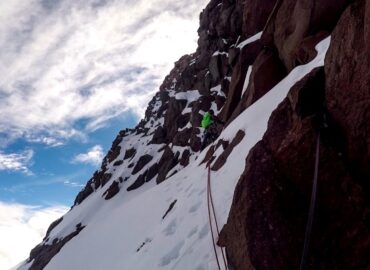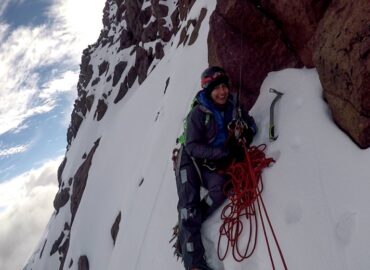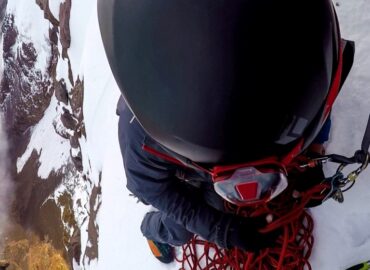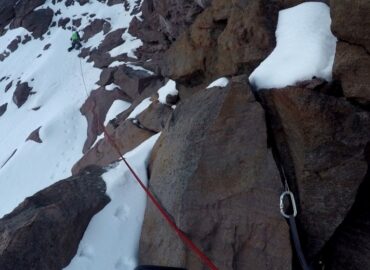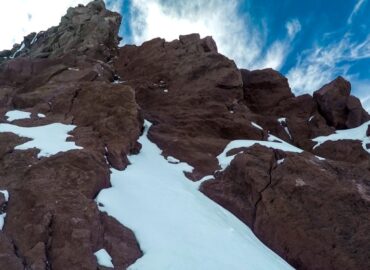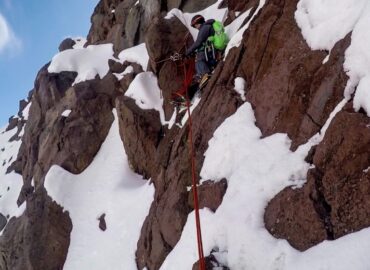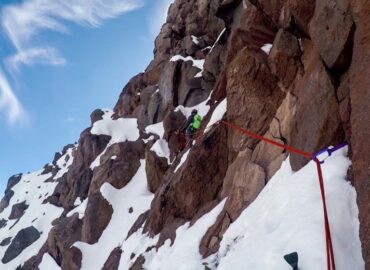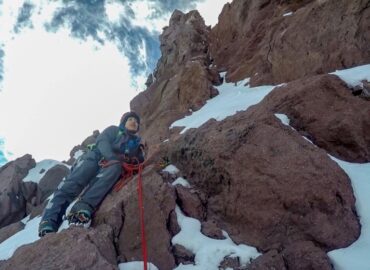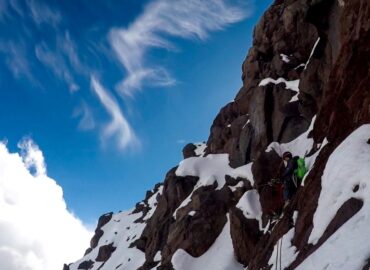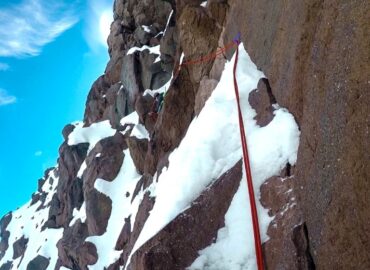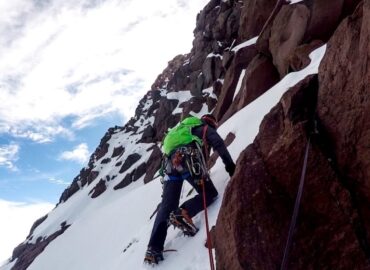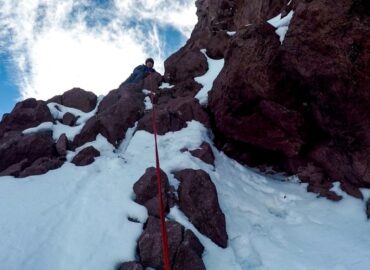Climbing report
I picked up Walter, Cornelia and Pablo at approximately 9 in the morning. I planned to get to Cayambe, have breakfast, take us to the refuge in a rented truck, set up our camp and, after lunch, climb a beautiful glacier, finally at night, we would hit the “Arista Santa Bárbara” route. Of course, if the weather allowed it and if not, do it by the normal route.
But… as the fourth law of my Life Manual dictates, “Never make long-term plans”, my instinct told me that we would not be able to follow the plan. In fact, the changes started since I picked up the guys late, which was causing the plan to lose its essence. We arrived in Cayambe at lunchtime, and to reduce costs we shared a truck with some colleagues from the CAP. Not to mention how late we got to the refuge … sure, in conjunction with a light drizzle that would scare the average son-of-the-urbe and we gave up on the plan to put together a couple of ice climbing routes.
It must be emphasized that what made us give up climbing the Beautiful Glacier was not the drizzle. We are peculiar beings. Beings who can be happy with a shared sip of hot water, sweetened with just a little sugar, in the middle of a storm. Hungry, cold, exhausted from fatigue. What made us give up was the fact that we barely had a couple of hours to get the equipment ready, eat, rest and get up again to start the punch..
So, in honor of the time, and to optimize the two hours that we had left, we decided to briefly analyze the strategy we would take for the route and play some good games of “40” with our CAP teammates, of course, so as not to leave to celebrate in Quito, beloved land.
Result of the strategy: with the uncertainty of a route that we had never tried before, we agreed to leave at 10 PM, to solve any unforeseen event.
Start.
Going to the summit through the Santa Barbara Ridge sounds easier than it is. The people you ask don’t give out-of-this-world recommendations – that you should be careful, they say. That a guide had to be rescued a couple of months ago, they say. Don’t forget hydration, ice axes, crampons, they say. Well, let me anticipate that those recommendations were diminished in the ascent, because we had to discover everything in the middle of the hit. Already in our homes, investigating, we also discovered that this route is considered one of the most difficult and technically most strenuous in the country, it has a TD graduation on a French scale, and the Aseguim Guides take their courses on that route.
But let’s go to the detail of how we did it: We took the normal route from the camp to the side of the refuge, for this, we had to go around the terrain to the lowest glaciers of the mountain. These glaciers are far from the Normal Route of Cayambe and are rarely crossed. The terrain is inhospitable and, if in the normal route it is common to find cracks, then to get an idea, take the cracks that are in the normal route multiply it by infinity and you will not have a hint of what we are talking about. It was common to see endless lines that indicated the path of the stones or detached ice and to walk among the remains thrown by the mountain.
The tension increased that no one dared to comment on. We advanced with the greatest possible care and, after the unusual landscape of cracks that we left behind, we managed to see a few dozen cracks ahead, without imagining that a huge rocky wall was waiting for us that would start our true “Saint Barbara Ridge”.
Mounting the ridge seemed the most difficult part of the journey. Due to the amount of loose rock and the lack of light, there were no complicated steps to be seen, but as we progressed we realized how wrong we were. We start progressing simultaneously, until we reach multi-length progression. We progress for an hour along the ridge and at 5 in the morning we reach the base of a wall of approximately 200 meters. “What?! Where are we coming to get in ?! ” …
As the darkness of the night still covered us, and the hardest part of the route was coming, we decided to rest, eat something and plan the next section until dawn.
The wall.
With the first rays of the sun we started to climb again, the route was quite broken and with a thin layer of snow in some places and exposed rock. According to the recommendations that they made us, we were within the itinerary. Although we found several tapes and stations where apparently other ropeways perhaps gave up the route when they discovered the monster in front of them, that was not our case.
We set up our new anchorage, and started a journey to the east, with some rubbish snow that was not enough to keep the ice axes fixed and did not allow us to safely dry tooling. So, the mechanics of the crossing consisted of hitting the snow with all the force (in addition to the hope that it is safe) and feeling how the vibrations, product of the impact with the hard rock, traveled through the blade, the handle, the ulna and radius, up to the skull. The vibrating pain was insignificant at the fact of seeing the unstable snow that was detached from the stone as if a child had broken and reassembled it, in such a way that his mother did not notice; but with the slightest movement the arrangement gave him away. That’s how fragile the snow was. The same thing was repeated at each step. We could not forget that a mistake meant a fall of a few hundred meters to nothing, which increased the excitement of the tour.
We advanced about 30 meters on an almost vertical wall (89.9 °) with only intermediate safety. We were motivated by what was to come: a vertical ascent of the same type, but with even more complex steps that we dodged by making progressions of 20 or 30 meters, without placing protections on the ground.
In the second full length, suddenly a snore was heard that progressively increased in intensity. The snore of the mountain before waking up. It was a gigantic avalanche a few dozen meters to the left of where we were, that welcomed us. Oh, blessed Santa Barbara, he is holy himself!
I had never seen or heard of anything like this, tons and tons of ice were breaking off the mountain, raising a great curtain of snow that was slow to dissipate.
We thanked Santa Bárbara that we were not in that area and, after we stopped thinking about what would have happened if …, we continued climbing.
After climbing almost 100 meters I made a bad step and slipped, although I did not suffer a big fall, I dislocated my shoulder and in the middle of a very exposed wall and with a lot of fear, I put my shoulder in its place, “Rambo” style (Thank goodness my partner did not cut the rope when he hung up accommodating my shoulder). With my shoulder in place, we considered resting a few minutes, although we lost a lot of time and energy due to my fall, given the difficulty and pain at this point, I was exhausted and just wanted to finish the edge.
Several tens of meters later, on an excessively exposed road, we reached a snow slope that would connect with the maximum summit. To our surprise there was a crack almost 15 meters wide that prevented us from reaching the summit. Oh, Santa Barbara. We decided to skirt the crack and find the way down from the normal route. In the search we found an ice bridge 60 cm thick and 50 cm deep, but after having saved ourselves from the avalanche, we preferred not to tempt our luck and continue looking. We found snow too loose that in some cases it totally covered our legs and a huge cliff. Each step was critical and time consuming as it took at least 4 minutes to pack the snow and continue.
After traversing gigantic crevasses, ice bridges, loose snow, and breathing sulfur, we finally found our way back. Thanks Santa Barbara. We were totally exhausted and the hardest part of all was missing: the descent.
After a few hours of being in solitary confinement, we managed to contact Cornelia and Pablo, who were waiting for us at the base camp, we asked them not to abandon us, that we were fine and it was not necessary for them to ask to be rescued, and that a couple of hours would arrive, we agreed to meet on the way to the sandy area and we continued with the descent. We arrived at the camp at approximately 6PM. The journey lasted 20 hours and was extremely exhausting, but we got there.
Thank you Corne and Pablo, for you, with gratitude and love
Author: HENRY MANOSALVAS
